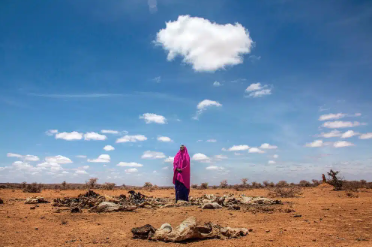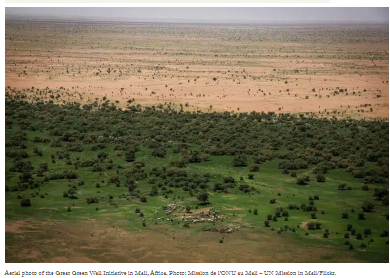
Around the world, huge swathes of fertile land are turning into arid wastelands at alarming rates, threatening ecosystems, agriculture, and humanity. This process is known as desertification, and it is closely linked to the effects of climate change.
Desertification is accelerating due to rising temperatures, erratic weather patterns, and human activities. The consequences of desertification are devastating, affecting food security, biodiversity, and the stability of economies. Understanding the connection between climate change and desertification is crucial to mitigating its impact and preserving the resources of the planet.
Drivers of Desertification
One main driver of desertification is rising global temperatures, which have led to increased rates of evaporation and less soil moisture, causing vegetation to die. When a region is already prone to arid conditions, it creates a cycle: vegetation loss depletes the nutrients in the soil, which in turn causes the land to become even more vulnerable to erosion. With no plant cover, the fertile ground then turns into a lifeless area.
Erratic weather patterns can also contribute to desertification. Droughts can leave land dehydrated for years, while intense rainfall can wash away topsoil as opposed to replenishing it. Land affected by these extreme events will struggle to recover, and eventually become inhabitable for plant and animal life. Certain regions, such as the Sahel in Africa and parts of Central Asia, are examples of how climate change can exacerbate desertification.
Unfortunately, humanity has also played a part in desertification. Overgrazing by livestock, deforestation, and unsustainable agricultural practices have been shown to degrade land. These practices reduce ecosystem resilience, which makes them vulnerable to the stress due to climate change. When fertile lands are lost, local communities are faced with food shortages, which forces them to expand agricultural activities into any remaining natural ecosystems, continuing the cycle of degradation.
While the consequences of desertification are universal, its impacts can vary depending on the region. One way to understand the connection between climate change and desertification is to analyze case studies in specific regions where the effects of desertification are most prominent.
Case Studies
The Sahel is a region in Africa that is semi-arid and is located south of the Sahara Desert. The Sahel has faced intense challenges due to climate change, such as prolonged droughts and failed agricultural cycles due to rising temperatures and erratic rainfall patterns. One 2022 report published by the Council on Foreign Relations showed that the region’s annual rainfall had decreased by up to 30% compared to the 1950s, exacerbating soil erosion and loss of vegetation. This vicious cycle transformed fertile land into an arid wasteland, displacing local communities and wildlife. Projects such as the “Great Green Wall”, which involves planting trees across the Sahel, have strived to mitigate desertification. However, the limited funding and governance challenges have resulted in little progress.
Parts of the American Southwest have also struggled with desertification. Some of these states include New Mexico, Texas, and Arizona, all of which have undergone significant impacts from prolonged droughts, poor land management practices, and reduced snowpack in the Rockies, a vital source of water. Overgrazing and urban sprawl in these regions have also contributed to the loss of productive land. A 2021 report by the National Oceanic and Atmospheric Administration showed that the ongoing drought conditions in the Southwest are some of the worst in 1,200 years. The local ecosystems and agricultural industries are also facing challenges due to the water shortages affecting areas like Lake Mead and the Colorado River.
Australia’s naturally arid regions are also vulnerable to desertification. Rising temperatures and prolonged droughts have severely impacted areas such as the Murray-Darling Basin, one of Australia’s most important agricultural zones. Australia’s Commonwealth Scientific and Industrial Research Organisation states that soil degradation, over-irrigation, and deforestation have made much of the land unsuitable for farming. Extreme heatwaves and bushfires have also caused a loss of vegetation and has exacerbated the process of desertification. Australian farmers have been working to mitigate these effects by adopting regenerative agricultural techniques such as reforestation and cover cropping.
When taking a look at these case studies, it is evident that desertification is a global crisis that is driven by climate change and human activities. Working to understand the unique challenges faced by each of these regions is one way that solutions for desertification can be developed.

Consequences of Desertification
There are many consequences that arise from desertification, specifically in regions that have communities which rely on land for livestock grazing and farming. When land degrades, it loses the ability to retain moisture and support vegetation growth. This leads to reduced pasture for livestock and declined crop yields. When this happens, farmers will usually have to rely on artificial irrigation and chemical fertilizers, which puts even more of a strain on the water resources.
When land becomes barren, communities may have to leave their homes to find areas with fertile land. Environmental degradation has caused populations to become displaced and has forced them to migrate in an effort to find land that can support them. Millions of people are at risk of displacement because of desertification, mainly in regions Central Asia, parts of South America, and sub-Saharan Africa. This can also cause overcrowding, competition for resources, and conflicts when displaced communities find themselves moving to neighboring regions.
Desertification also poses a threat to biodiversity. Many plant and animal species rely on stable ecosystems for survival. Without fertile lands, their habitats will shrink, causing species to be forced to adapt to the new conditions. When plants that prevent soil erosion and aid in soil stability disappear, the cycle of degradation only accelerates. Animals that depend on these ecosystems for habitat cover and food also struggle with declining resources, which leads to endangerment or extinction within the ecosystem. The loss of plant life also contributes to reduced carbon sequestration and thus climate change.
Addressing Desertification
In order to combat desertification, both global and local efforts are required. Some techniques that play a role in restoring degraded areas and preventing further loss of fertile land are reforestation, where trees are planted to stabilize soil and improve moisture retention, and agroforestry, which involves the intentional planting of trees and shrubs with crops and animals to benefit the environment. Both practices can help to reduce the risk of erosion and climate variability. On a global scale, initiatives such as the United Nations’ Land Degradation Neutrality (LDN) program focus on putting a stop to desertification and reversing its effects by encouraging countries to adopt sustainable practices. The LDN program provides comprehensive information on degraded land restoration, improving food security, and steps to improve ecosystem resilience. It also seeks to raise awareness of land conservation and its importance while providing technical and financial assistance to regions that are at risk. But addressing desertification involves addressing the root cause, too: climate change. In order to mitigate the rising temperatures and erratic weather patterns that have accelerated land degradation, it is imperative to focus on reducing greenhouse gas emissions.
Doing this will require shifting towards renewable energy and promoting more sustainable agricultural practices. A combination of these efforts can help to protect ecosystems, livelihoods, and reduce displacement of communities
Article Credit: earth